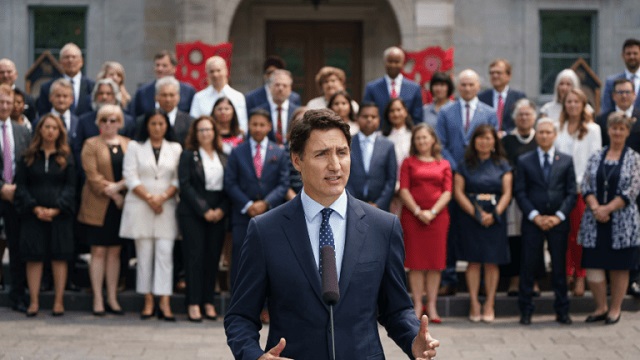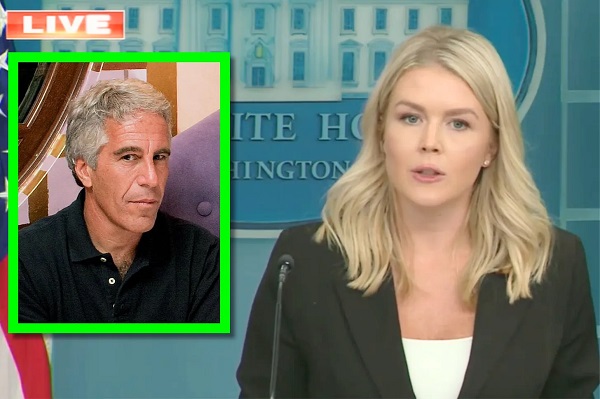Business
The government surrenders to reality with rewritten Online News Act—and pleases no one: Peter Menzies

From the MacDonald Laurier Institute
By Peter Menzies
The shakedown of Meta and Google didn’t go as planned—but now they’re eyeing other lucrative targets.
There were some long faces in the news industry last week when Heritage Minister Pascale St-Onge rolled out the final terms of her surrender to reality.
Media executives who once campaigned for the Online News Act with sugar-plum visions of Big Tech cash dancing in their heads were left to deal with some pretty serious lumps of coal. After years of effort to procure what they once fancied would be hundreds of millions of dollars annually from web giants, all St-Onge could bring down the chimney was a bump up in Google’s spend to $100 million.
How much the mother of all search engines was already paying to publishers is unknown, but in-the-know estimates tend to range from $30-$50 million. Splitting the difference at $40 million would mean the industry—newspapers, broadcasters, and online platforms—wound up with $60 million in fresh cash, give or take.
That’s less than the Lotto Max jackpot Rhonda Malesku of Kamloops and Ruth Bowes of Edmonton shared last summer. A lot of money for Rhonda and Ruth for sure, but for an entire industry it’s a drop in a leaky bucket.
Then there’s the fact the Act resulted in Meta blocking all news links in Canada on Facebook and Instagram. Again, the exact cost is unknown but the social media company had been spending $18 million on journalism supports plus—and here is the killer—Meta estimated it had been sending $230 million a year worth of referrals to news websites.
Even if Meta is only half right, that still leaves the news industry many tens of millions of dollars worse off. If Meta’s estimate is accurate—and no one has really debunked it—the scenario is a lot uglier.
This is what happens when you make things up.
The Act was rooted in the make-believe premise that “web giants” were profiting from “stealing” news. Legislation was designed on that basis to force Big Tech to “negotiate” commercial deals and share those profits with all news organizations.
In the end, as Michael Geist has detailed, that charade of “compensation” was dropped as the government, desperately afraid Google would follow Meta’s lead, posted regulations that essentially rewrote the Act to suit the search engine and, as an aside, puzzle lawyers. All that the media were able to salvage from the hustle was a fund they wound up fighting over like street urchins in a soup kitchen.
Here, St-Onge actually did something sensible. Her original plan was to have the fund distributed solely on a per journo basis. In other words, if there are 10,000 journalists, $100 million would turn into $10,000 per journo, never mind whether they are paid $35,000 or $150,000. The problem with that is that one in three Canadian reporters works for CBC, which is not in mortal peril. The next highest is Bell Media, whose parent company made $10 billion last year. Meanwhile, the Toronto Star is hemorrhaging at a rate of $1 million a week, small centres are becoming news deserts, and Postmedia’s stable of zombie newspapers continues to, well, zombie on.
Broadcasters would have consumed 75 percent of the loot and the vast majority of the cash would wind up with companies for whom news is not a primary aspect of their operations.
St-Onge changed that to cap private broadcasters’ windfall at 30 percent, with CBC limited to 7 percent.
That means 63 percent of the money will go to operators in the greatest peril which, for a fund resulting from a need to address industrial poverty, is at least rational.
Still, there was grumbling.
“Well, this is disappointing—sure wasn’t expecting a cap on broadcasters’ access to compensation,” Tandy Yull, vice president of policy and regulatory affairs for the Canadian Association of Broadcasters, posted on LinkedIn.
“Hey, Universe! More needs to be done to support Canadians’ most important providers of news, local radio, and television stations, who are facing significant—even existential—declines in advertising revenue,” she added.
Yull went on to stake broadcasters’ claim to government assistance currently reserved for newspapers and online-only media: the Journalism Labour Tax Credit and the Local Journalism Initiative.
And of course “our democracy demands that we explore these and other options—soon.”
She may not have long to wait.
Broadcasters opened up a fresh lobbying for loot campaign just last month when the Canadian Radio-television and Telecommunications Commission (CRTC) held a hearing to launch the implementation of the Online Streaming Act.
Supposedly about funding Canadian entertainment programming, the concept of a news fund was introduced early and repeated often.
Commissioners appeared happy to embrace well-worn lines about a news “crisis” that needs “urgent” attention to prevent—cue the tympany—the death of democracy. And they did so without needing to be persuaded there was any rational reason for creating a fund which, logically, makes no more sense than taxing cinemas to pay for newspapers. Nor were any concerns raised about impacts on entrepreneurship and online innovators.
“Local news is in crisis and requires immediate intervention,” Susan Wheeler of Rogers, which made $7.12 billion last year, told the panel.
“A fundamental outcome of the modernized contribution regime must include new mechanisms to provide long‑term financial support for high‑quality Canadian‑produced broadcast news from credible outlets,” she said, calling for 30 percent of money raised from foreign online streaming companies to be directed to a news fund “accessible by all private TV and radio stations producing news.”
The humiliating squabbling over the remnant scraps of the Online News Act clearly wasn’t the end of the Great Canadian Quest for other people’s money.
So maybe the shakedown of Meta and Google didn’t quite work out. But Spotify, Disney+, and Netflix? They have money. Let’s mug them instead.
It’s not like anything bad could happen. Right?
Peter Menzies is a Senior Fellow with the Macdonald-Laurier Institute, a former newspaper executive, and past vice chair of the CRTC.
Automotive
Federal government should swiftly axe foolish EV mandate

From the Fraser Institute
Two recent events exemplify the fundamental irrationality that is Canada’s electric vehicle (EV) policy.
First, the Carney government re-committed to Justin Trudeau’s EV transition mandate that by 2035 all (that’s 100 per cent) of new car sales in Canada consist of “zero emission vehicles” including battery EVs, plug-in hybrid EVs and fuel-cell powered vehicles (which are virtually non-existent in today’s market). This policy has been a foolish idea since inception. The mass of car-buyers in Canada showed little desire to buy them in 2022, when the government announced the plan, and they still don’t want them.
Second, President Trump’s “Big Beautiful” budget bill has slashed taxpayer subsidies for buying new and used EVs, ended federal support for EV charging stations, and limited the ability of states to use fuel standards to force EVs onto the sales lot. Of course, Canada should not craft policy to simply match U.S. policy, but in light of policy changes south of the border Canadian policymakers would be wise to give their own EV policies a rethink.
And in this case, a rethink—that is, scrapping Ottawa’s mandate—would only benefit most Canadians. Indeed, most Canadians disapprove of the mandate; most do not want to buy EVs; most can’t afford to buy EVs (which are more expensive than traditional internal combustion vehicles and more expensive to insure and repair); and if they do manage to swing the cost of an EV, most will likely find it difficult to find public charging stations.
Also, consider this. Globally, the mining sector likely lacks the ability to keep up with the supply of metals needed to produce EVs and satisfy government mandates like we have in Canada, potentially further driving up production costs and ultimately sticker prices.
Finally, if you’re worried about losing the climate and environmental benefits of an EV transition, you should, well, not worry that much. The benefits of vehicle electrification for climate/environmental risk reduction have been oversold. In some circumstances EVs can help reduce GHG emissions—in others, they can make them worse. It depends on the fuel used to generate electricity used to charge them. And EVs have environmental negatives of their own—their fancy tires cause a lot of fine particulate pollution, one of the more harmful types of air pollution that can affect our health. And when they burst into flames (which they do with disturbing regularity) they spew toxic metals and plastics into the air with abandon.
So, to sum up in point form. Prime Minister Carney’s government has re-upped its commitment to the Trudeau-era 2035 EV mandate even while Canadians have shown for years that most don’t want to buy them. EVs don’t provide meaningful environmental benefits. They represent the worst of public policy (picking winning or losing technologies in mass markets). They are unjust (tax-robbing people who can’t afford them to subsidize those who can). And taxpayer-funded “investments” in EVs and EV-battery technology will likely be wasted in light of the diminishing U.S. market for Canadian EV tech.
If ever there was a policy so justifiably axed on its failed merits, it’s Ottawa’s EV mandate. Hopefully, the pragmatists we’ve heard much about since Carney’s election victory will acknowledge EV reality.
Business
Prime minister can make good on campaign promise by reforming Canada Health Act

From the Fraser Institute
While running for the job of leading the country, Prime Minister Carney promised to defend the Canada Health Act (CHA) and build a health-care system Canadians can be proud of. Unfortunately, to have any hope of accomplishing the latter promise, he must break the former and reform the CHA.
As long as Ottawa upholds and maintains the CHA in its current form, Canadians will not have a timely, accessible and high-quality universal health-care system they can be proud of.
Consider for a moment the remarkably poor state of health care in Canada today. According to international comparisons of universal health-care systems, Canadians endure some of the lowest access to physicians, medical technologies and hospital beds in the developed world, and wait in queues for health care that routinely rank among the longest in the developed world. This is all happening despite Canadians paying for one of the developed world’s most expensive universal-access health-care systems.
None of this is new. Canada’s poor ranking in the availability of services—despite high spending—reaches back at least two decades. And wait times for health care have nearly tripled since the early 1990s. Back then, in 1993, Canadians could expect to wait 9.3 weeks for medical treatment after GP referral compared to 30 weeks in 2024.
But fortunately, we can find the solutions to our health-care woes in other countries such as Germany, Switzerland, the Netherlands and Australia, which all provide more timely access to quality universal care. Every one of these countries requires patient cost-sharing for physician and hospital services, and allows private competition in the delivery of universally accessible services with money following patients to hospitals and surgical clinics. And all these countries allow private purchases of health care, as this reduces the burden on the publicly-funded system and creates a valuable pressure valve for it.
And this brings us back to the CHA, which contains the federal government’s requirements for provincial policymaking. To receive their full federal cash transfers for health care from Ottawa (totalling nearly $55 billion in 2025/26) provinces must abide by CHA rules and regulations.
And therein lies the rub—the CHA expressly disallows requiring patients to share the cost of treatment while the CHA’s often vaguely defined terms and conditions have been used by federal governments to discourage a larger role for the private sector in the delivery of health-care services.
Clearly, it’s time for Ottawa’s approach to reflect a more contemporary understanding of how to structure a truly world-class universal health-care system.
Prime Minister Carney can begin by learning from the federal government’s own welfare reforms in the 1990s, which reduced federal transfers and allowed provinces more flexibility with policymaking. The resulting period of provincial policy innovation reduced welfare dependency and government spending on social assistance (i.e. savings for taxpayers). When Ottawa stepped back and allowed the provinces to vary policy to their unique circumstances, Canadians got improved outcomes for fewer dollars.
We need that same approach for health care today, and it begins with the federal government reforming the CHA to expressly allow provinces the ability to explore alternate policy approaches, while maintaining the foundational principles of universality.
Next, the Carney government should either hold cash transfers for health care constant (in nominal terms), reduce them or eliminate them entirely with a concordant reduction in federal taxes. By reducing (or eliminating) the pool of cash tied to the strings of the CHA, provinces would have greater freedom to pursue reform policies they consider to be in the best interests of their residents without federal intervention.
After more than four decades of effectively mandating failing health policy, it’s high time to remove ambiguity and minimize uncertainty—and the potential for politically motivated interpretations—in the CHA. If Prime Minister Carney wants Canadians to finally have a world-class health-care system then can be proud of, he should allow the provinces to choose their own set of universal health-care policies. The first step is to fix, rather than defend, the 40-year-old legislation holding the provinces back.
-

 Bruce Dowbiggin2 days ago
Bruce Dowbiggin2 days agoEau Canada! Join Us In An Inclusive New National Anthem
-

 Crime2 days ago
Crime2 days agoEyebrows Raise as Karoline Leavitt Answers Tough Questions About Epstein
-

 Business2 days ago
Business2 days agoCarney’s new agenda faces old Canadian problems
-

 Alberta2 days ago
Alberta2 days agoCOWBOY UP! Pierre Poilievre Promises to Fight for Oil and Gas, a Stronger Military and the Interests of Western Canada
-

 Alberta2 days ago
Alberta2 days agoAlberta and Ontario sign agreements to drive oil and gas pipelines, energy corridors, and repeal investment blocking federal policies
-

 Crime1 day ago
Crime1 day ago“This is a total fucking disaster”
-

 International2 days ago
International2 days agoChicago suburb purchases childhood home of Pope Leo XIV
-

 Fraser Institute1 day ago
Fraser Institute1 day agoBefore Trudeau average annual immigration was 617,800. Under Trudeau number skyrocketted to 1.4 million annually





